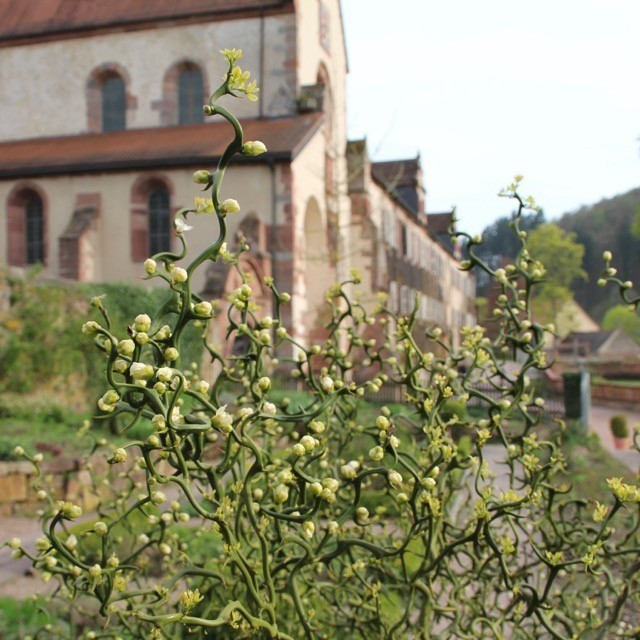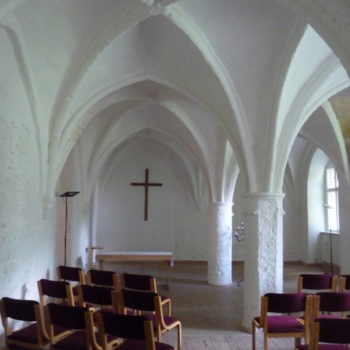One of the most important achievements of Western monasticism in terms of culture and civilization was the ability to introduce written forms, and thus a new and far-reaching system, into all areas of economic life. The high culture of writing can almost be described as a hallmark of European monasticism. This was already evident in the Rule of St Benedict of Nursia written in the 6th century, which is one of the most important foundations of Western monasticism. The abbot is supposed to entrust the monastery’s tools and equipment only to brothers who are of strong character – i.e. who handle them with care. In addition, the abbot is also supposed to keep a register (breviarium) so that he knows what he has handed out and what was returned, in the event that brothers relieve each other with certain tasks (Rule of St Benedict, Chapter 32).
Much of what was still widely described some decades ago in popular and academic literature as particular achievements of monks has been put into perspective by more recent research. The famous Brandenburg writer Theodor Fontane (1819-1898), for example, portrayed the Cistercians as an order of colonisers who brought culture to the Brandenburg wilderness with a cross in their left hand and an axe and spade in their right. However, this simplified view has come under criticism, although
»(…) extreme judgements are not tenable. The Cistercians did not move into the wilderness as colonisers to build model estates for the peasants, nor were they smug and indolent monks who settled in a well-feathered nest having others provide for it. They organised their environment according to their own ideas, and these ideas were economically up to date, but in many respects, they no longer match with the intentions of late 19th century monks.«[i]
The clerical orders’ activities to organise the environment according to their ideas resulted in continually expanded bookkeeping – which already had its basis in the mentioned Rule of St Benedict to always keep orderly lists. Over the centuries, they became increasingly sophisticated in their »systematic use of scripture as a storage medium« and applied it in an innovative way in their legal and administrative texts.[ii]
The more successful the monasteries became, the more demanding the requirements of bookkeeping became: »Business enterprises, such as those established by the Cistercians, required precise operational management in order to survive in the long term. There exists an early manual in the economic regulations of Abbot Stephan Lexington for the Savigny monastery from 1230.« It also applied »(…) to the conversi working on the monastic granges, who had to keep regular accounts of everything they were responsible for inside and outside the house. Every year a work report was required, which was to show the extent to which the economy in the respective area had improved or deteriorated. (…) Finally, once a year in late autumn, an overall account was to be presented to the abbot and the council of the house in order to assess what benefits were to be expected in the future.«[iii]
The external properties of the monasteries began to keep their own books and accounts. In the Fritzlar Stadthof, the urban office of Hardehausen monastery, for example, there was a master who specialised in writing (magister specialiter habet in scripto): »The numerous leases and diverse forms of taxation in the urban area often made it necessary for records to be kept in the Stadthof rather than in the monastery, as was the case with the common agricultural estates. In monastery ownership registers, the following entries are found for such towns: the details, the names and locations of the estates, the owners and their tax obligations, all kept by the Hofmeister (master of the household) in his book, or in short: magister specialiter habet in scripto.«[iv] Certainly, such forms of economic management could also have an exemplary effect on other businesses or economic activities in towns.
There is an impressive testimony to the fact that monasteries orientated themselves towards the most modern methods of administration of their time, the so-called Neuzelle Abbey Atlas. The atlas, which was produced for Neuzelle Abbey between 1758 and 1763 following surveys of the monastery under the abbots Martin and Gabriel, is carefully drawn by hand and delicately colourized. It contains, among other things, a general plan of the abbey and detailed maps of the abbey’s villages with their fields. A second volume of the atlas contains a description of the Neuzelle abbey territories from 1760 with extracts from the survey registers and descriptions of the various monastery estates[v]:
»The survey of all estates and the creation of field registers shows how important good administration was to the monastery in the 18th century. The pinnacle of these efforts is the Neuzelle Abbey Atlas, in which most of the villages in the dominion are mapped and recorded and which now ranks among the treasures of the German State Library in Berlin.«[vi]
Evidence of such methods of systematisation and communication of knowledge via media can be found very early in in the monastic sphere. In the anthology L’hydraulique monastique, published in 1996, various authors state that, admittedly, the hydraulic engineering techniques of monks in the Middle Ages cannot be regarded as an invention of the monasteries. However, they do show that they closely observed their environment and were able to use the know-how they had acquired, develop it further and, above all, spread it rapidly to other monasteries. The latter in particular was obviously the focus of monastic innovative activities. The monks were able to systematise existing techniques in political and organisational ways, not least because of their ability to make rational use of writing. The work of the Cistercians in the Poitou moorland, for example, is remarkable in this context:
»After the limited and in a sense disorganised draining during the prehistoric period, the white monks introduced coherent drainage plans starting about 1180 to 1190, which were carried out as part of the coordination between their abbeys, or as part of common feudal contracts with the secular feudal lords of Marans, Chaillé and Luçon. They improved the technology of the drained area.«[vii]
The degree of how closely monasteries were observing technical innovations is shown in a drawing of a mill in the work Hortus Deliciarum (Garden of Delicacies) by Herrad von Landsberg, who was the outstanding abbess of the monastery on Mont Sainte-Odile in Alsace in the 12th century.[viii]
Secular rulers, too, naturally drew on the special abilities of clergymen to record acts of authority in writing. Beyond the Middle Ages, this art was of central importance for the cultural memory of societies. At the princely courts, it was mainly monastics who produced written documents, not in monastic seclusion, however, they were often trained in monasteries. The French historian Georges Duby (1919-1996) commented on this: The princes
»(…) also needed clergymen, educated people who did not live in isolation from the world and were not only occupied with praying, but also helped them to keep their accounts and draw up the documents without which the resurging state could no longer manage.«[ix]
Indeed, the close relationship of monks and nuns to the written word could also – and this shall by no means be concealed at this point – produce strange, sometimes criminal, effects. A large number of forged documents have survived at a number of monasteries and other ecclesiastical institutions, which already have puzzled several generations of historians. For example, several documents were produced at Dobrilugk Abbey that were supposedly issued by Margrave Conrad II and Margrave Theodoric the Oppressed at around 1200. In more recent times, they were to serve as evidence for the monks in dispute with their neighbours[x]. Here, certain fame in historical research was achieved by the medieval forgery workshop of the Augustinian monastery of St Mary on the Hill outside Altenburg. Historian Hans Patze summarised his observations as follows:
»Almost completely preserved, the archive of documents from the Altenburg monastery impressively demonstrates how its canons mastered the art of document production, passed it on from generation to generation and finally mastered their craft to the point of successful fraud.«[xi]
Some of this may be reminiscent of the medieval thriller The Name of the Rose by Umberto Eco, but historians such as Heinz Quirin and Horst Fuhrmann have pointed out that forgers of documents often did not feel they were in the wrong, because they were helping a higher truth to prevail. And who would be representing a more just cause if not a monk fighting for his monastery?
However, this marginal note is not meant to dominate our picture. Monasteries have undoubtedly rendered important services to our culture in the field of writing and text. According to historian Gert Melville, the tendency of monks to think in long periods of time and to pass on events and ways of living to subsequent generations turned monasteries with their chronicles and their texts on administration and law into laboratories of innovation for European concepts of life and models of order.[xii] University institutions have emerged from Dominican study centres such as the one in Cologne. The legacy of monasteries in today’s culture of knowledge cannot be overlooked.



